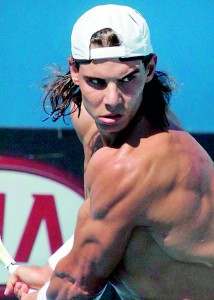Rafael Nadal – The Spanish special
View(s):With or without bandaged knee the swashbuckling ‘Rafael Nadal’ took Barcelona and Madrid 2013 clay titles in a sensational way. Federer, Murray and Djokovic went out in the early rounds of these tournaments.
Nadal’s name in Spain is etched on stone like another Spaniard called ‘El Cordobes’- Manuel Benites- a bull fighter.
Ritualised Bull fighting is a passion of Spain. El Cordobes born in 1936 described as a gypsy orphan, manual worker and a bull fighter. He broke every ritualised rule and took every bull he faced in a sensational Spanish way. I have seen Senoritas throwing their shoes and clothing at him into the bull ring after his performances. Nadal is another such legend with his unique Tennis game.
Speed control as tactic
Tactically, ‘speed’ can acts both ways; for you and against. Do not out-pace yourself. Some of the tactics in Tennis cannot be seen but only sensed while playing. Nadal’s shrewd selection of pace to accommodate himself comfortably and to punish the opponent to the fullest extent is well controlled and is a treat to see.
Jimmy Connors and Federer also did this but not to the effectiveness of Nadal. Nadal’s is very effective in controlling the overall speed of the rally with spin/pace ratio. In the semis and finals of Barcelona and Madrid 2013 against Spaniards Nicolas Almagro, Pablo Andujar, and Swiss Warwinka, Nadal’s pace control made every move of the opponent ineffective. With a little practice position and speed mapping charts can track this aspect.
The core of this pace control idea lies in the art of acquiring the repositioning time for the next shot from the shot that is played. If you give the ball quickly to the opponent when you are out of position it is bad for the business of winning. In other words playing high flight heavy shots which give more time when in difficult positions and attacking flat shots in good position is the right selection. Many inexperienced players trap themselves using the same speed all the time.
Getting out of trouble
‘I have to wait or pray for rain’ said Boris Becker when asked what he would do if his arch rival Pete Sampras was playing well. Nadal like all good players is very good at getting out of trouble when his opponents are performing well.
He can hang in and wait in the early part of the game when everything is fresh. In Barcelona 2013 finals Almagro had everything including a lead with service break to finish Nadal. In the first 5 games Nadal was not only losing but was without an answer. Almagro’s shots were flat and pierced like an arrow and did not give any time for Nadal to do well. But after 7 games Almagro’s feet slowed and his own shots did not give him time to reposition and that worked against him. Nadal was working and waiting for this. When it happened he turned the table and won the first set at 6/4. Nadal has done this many times very well.
Nadal’s few good shots
Do you remember Nadal at net volleying? Barely I guess! He serves and then plays well behind the baseline, picking up drop shots and playing drive volley from any part of the court. His game is weighted to play in the back half of the court. Only when he was injured I saw him at net and he lost most of those matches. His Tennis is a brand with few good shots. In the history of winning Tennis this strait is common. It comes from the game idea of leading the attack and not answering the attack.
To compose a game Nadal can make two winners with his serve or with his return of serve and then go to win two more with his ground strokes. This limitation of shots has become an advantage to Nadal’s quick shot selection process with profound effect. The most difficult thing in Tennis is play the simple shots effectively back. Nadal is worthy of a case study when it comes to this aspect. On the other hand Sampras and Federer are different. They did everything everywhere and won. Winning is an individual thing, a player’s realm.
Nadal’s 2nd serve
In Tennis second serve is punished. Two of the best returns of serves in recent times are from Federer and Djokovic. I have never seen them ever attack Nadal’s second serve. Nadal’s second serve has lot of speed and spin. These induce so much movement in the air and after the bounce making good contact a very difficult task. No player will consider adventures attack when reading the ball is difficult for contact. Match statistics have shown Nadal’s percentage of point won with second serve to be very high. It is another of his brand.
Although Nadal does not use the slice easily the slice backhand is appearing among others. This could lead to more net play in the

Rafael Nadal is very effective in controlling the overall speed of the rally with spin/pace ratio.
future. Slice is a reverse spin and it is a single handed shot that needs least amount of time to play. Players are also reaching the net in an untraditional way.
There are 3 more Clay tournaments in Europe. Rome is on now it will be followed by Strasbourg and French-Open in Paris. See how they do it in the French Open from 26th of May. Spanish special Nadal will be also there again for his 8th French Open title.
The crowd roars my name,
As if I am a warrior entering battle.
Chanting for me,
Willing me to win
That is how I must play,
A soldier at war,
Until I hear the words,
“Game, Set, Match.”
-georgepaldano@yahoo.com
Follow @timesonlinelk
comments powered by Disqus


